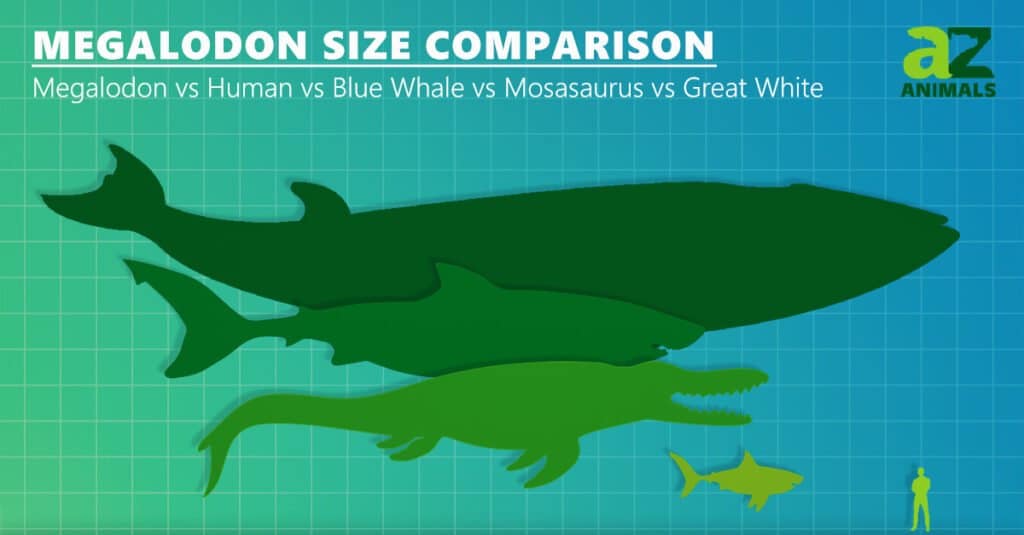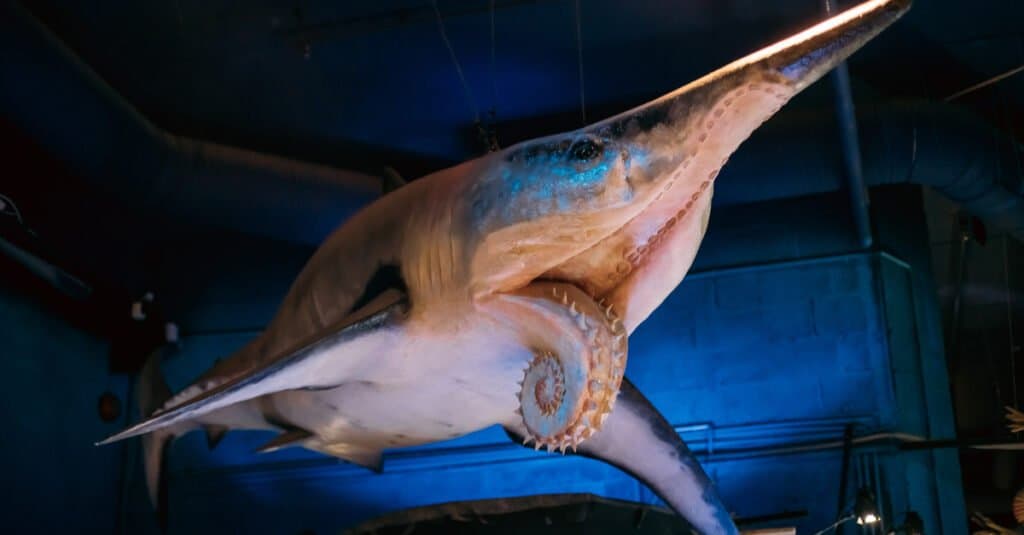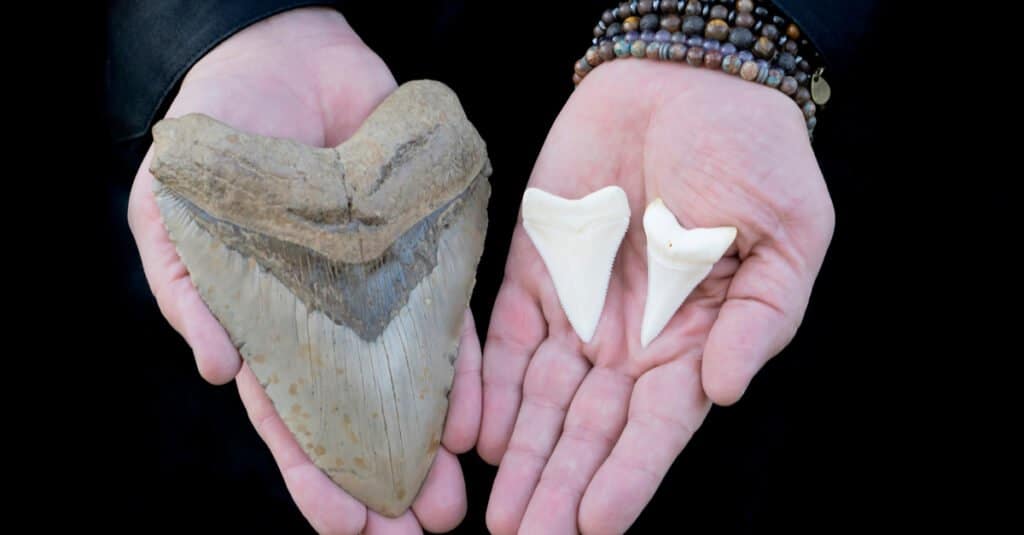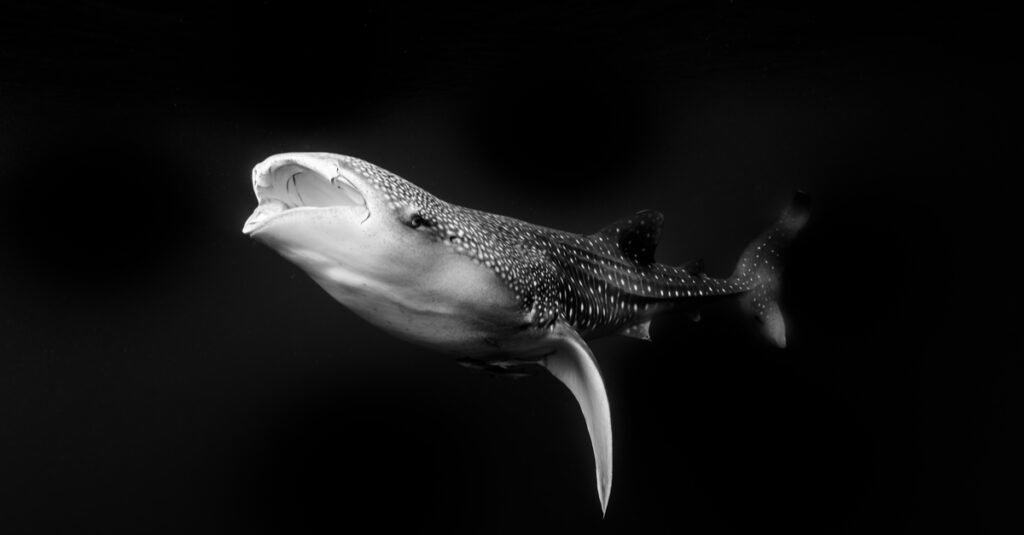In the world of sharks, few are more famous than the megalodon. They have been in movies, television, and pop culture for decades and instill a sense of fear in any who happen to look down while swimming. Thankfully, these massive sharks are extinct, but one of their cousins isn’t. Whale sharks may be the closest contender for King Shark in the ocean, but how do they compare? Let’s look at these two giants and see which was bigger, as well as some other interesting information. When it comes to the megalodon vs. whale shark, who wins?
Megalodon vs. Whale Shark: Which Was Bigger?

Megalodon is the largest shark to ever live, beating out the current winner, whale sharks.
©ilikeyellow/Shutterstock.com
Let’s take a look at these two sharks and compare their size. Looking at megalodons first, we have to make some assumptions. Megalodons are extinct and have been for around 2.6 million years. Knowing that, many of the facts we have on the species are guesses. Scientific guesses, surely, but still guesses.
Estimates of megalodons’ size reach a maximum of 20 meters (roughly 67 feet) long, according to the fossil record. Using those same estimates from a few different sources, it seems reasonable to guess that when it comes to weight, megalodons maxed out around 60 tons, or 120,000 lbs. To visualize their mass, imagine 41 compact cars stacked together and you start to get the picture. Additionally, their teeth (the ones we have fossilized) have been found to be as large as 7 inches. For perspective, a great white shark’s teeth average around 2 inches.
Whale sharks are the largest extant (living) fish species in the world. This makes them the largest shark species as well, but how do they compare to an extinct relative? On average, whale sharks reach 10 meters, or 22 feet long. At their maximum, whale sharks have been recorded at 61.7 feet long. As for weight, they average around 20 tons (41,000 lbs) but can get a little bigger.
Megalodons are a little longer and significantly heavier than whale sharks. Although whale sharks hold the title for largest shark alive, megalodons hold the title for largest shark ever.
What is bigger than the megalodon and the whale shark?

We know that megalodons were larger than the modern-day heavyweights like great whites, but were there other sharks in history that could have stacked up to the reigning king? Let’s take a look.
The closest competitor when it comes to predatory prehistoric sharks is probably the helicoprion. The helicoprion was 9.1 meters long (30 feet), a far cry from the megalodon. Although these sharks were smaller than a megalodon, their teeth look like something out of a horror film. They get their name from their mouth which contains a buzzsaw of teeth arranged in a spiral. Although they are terrifying, they simply don’t match up to the prehistoric megalodon.

Helicoprions were one of the largest prehistoric sharks.
©Grisha Bruev/Shutterstock.com
While not a shark, blue whales are significantly larger than both megalodons and whale sharks by quite the margin. Blue whales aren’t just the largest animals alive today, they are the largest animals to have ever lived on the earth. If megalodons were around today, blue whales would be larger by a significant margin.
How do megalodons and whale sharks hunt?

Megalodons were apex predators that used stealth for hunting.
©Mark_Kostich/Shutterstock.com
To sustain their size, each shark employs a specialized hunting strategy to gather the required energy needs each day.
Megalodons were carnivorous predators that ate baleen whales, sea turtles, toothed whales, and other sharks. With its massive size, nearly anything was on the menu for these apex predators. From the fossil record and known bite marks, it appears that megalodon mostly stuck to medium-sized prey with the occasional attempt at larger prey. The medium-sized prey would likely have been whales and other sharks and the larger instance being an attack on a sperm whale. Sperm whales can reach sizes of 130,000 pounds, a little bigger than the megalodon itself. Megalodon was likely a stealth hunter that would wait below its prey and explode upwards, taking a massive bite and waiting for the prey to die. Scientists estimate that megalodon needed to eat 2,500 lbs of food per day to maintain weight.
Whale sharks may be sharks, but they are passive filter feeders that don’t harm large animals. As filter feeders, whale sharks swim through the ocean with their mouths open, bringing in huge amounts of water. As the water rushes past, it passes through specialized structures known as filter pads. These filter pads are essentially sieves that stop any small food and allow water to pass out and through the gills. Using this method, whale sharks are able to passively obtain huge amounts of food with little energy expenditure. It’s for this reason that filter-feeding is so common among the largest ocean animals today. Their most common foods are plankton, fish eggs, and algae. Juvenile whale sharks can easily eat up to 45 lbs of food in a day.
Could a megalodon eat a whale shark?

Whale sharks may be the largest sharks alive, but megalodons would likely eat them if given the chance.
©paul cowell/Shutterstock.com
Whale sharks have been around in a similar form for nearly 245 million years. While the fossil record isn’t totally complete, it’s safe to say that some version of whale sharks existed around the time that megalodon was roaming the oceans. With that in mind, would a megalodon have eaten a whale shark if it came across it?
With its 7 inch teeth and predatory behavior, it’s possible that a megalodon would have attacked the prehistoric relatives of a whale shark if it was hungry enough. Whale sharks are born incredibly small and when they are growing, small fish like merlin and swordfish eat them today. Knowing that, it’s easy to imagine a megalodon wouldn’t have much issue taking out a juvenile whale shark without a problem.
When it comes to a full-sized whale shark, it probably wouldn’t be much of a match either. Although whale sharks have no natural predators when they are full-grown, a massive megalodon would likely be able to kill a whale shark. They have no defensive capabilities and purely rely on their size to deter predators. Since megalodons are so large, that deterrent wouldn’t do much. After a single bite and a fast bleed-out, the megalodon would have quite the feast on his hands.
The photo featured at the top of this post is © Gil Cohiba/Shutterstock.com
Thank you for reading! Have some feedback for us? Contact the AZ Animals editorial team.






